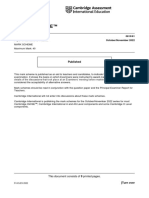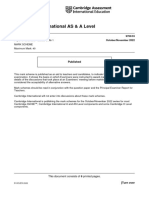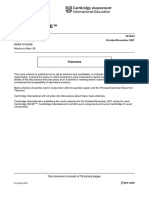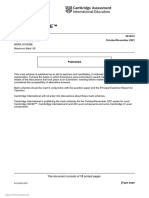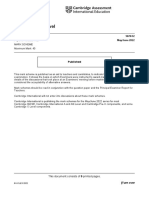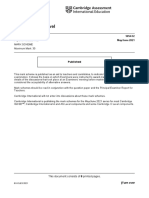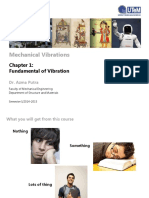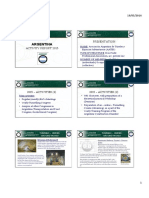Cambridge IGCSE ™: Biology 0610/42 October/November 2022
Cambridge IGCSE ™: Biology 0610/42 October/November 2022
Uploaded by
dharshini_perumalCopyright:
Available Formats
Cambridge IGCSE ™: Biology 0610/42 October/November 2022
Cambridge IGCSE ™: Biology 0610/42 October/November 2022
Uploaded by
dharshini_perumalOriginal Title
Copyright
Available Formats
Share this document
Did you find this document useful?
Is this content inappropriate?
Copyright:
Available Formats
Cambridge IGCSE ™: Biology 0610/42 October/November 2022
Cambridge IGCSE ™: Biology 0610/42 October/November 2022
Uploaded by
dharshini_perumalCopyright:
Available Formats
Cambridge IGCSE™
BIOLOGY 0610/42
Paper 4 Theory (Extended) October/November 2022
MARK SCHEME
Maximum Mark: 80
Published
This mark scheme is published as an aid to teachers and candidates, to indicate the requirements of the
examination. It shows the basis on which Examiners were instructed to award marks. It does not indicate the
details of the discussions that took place at an Examiners’ meeting before marking began, which would have
considered the acceptability of alternative answers.
Mark schemes should be read in conjunction with the question paper and the Principal Examiner Report for
Teachers.
Cambridge International will not enter into discussions about these mark schemes.
Cambridge International is publishing the mark schemes for the October/November 2022 series for most
Cambridge IGCSE™, Cambridge International A and AS Level components and some Cambridge O Level
components.
This document consists of 15 printed pages.
© UCLES 2022 [Turn over
0610/42 Cambridge IGCSE – Mark Scheme October/November 2022
PUBLISHED
Generic Marking Principles
These general marking principles must be applied by all examiners when marking candidate answers. They should be applied alongside the
specific content of the mark scheme or generic level descriptors for a question. Each question paper and mark scheme will also comply with these
marking principles.
GENERIC MARKING PRINCIPLE 1:
Marks must be awarded in line with:
• the specific content of the mark scheme or the generic level descriptors for the question
• the specific skills defined in the mark scheme or in the generic level descriptors for the question
• the standard of response required by a candidate as exemplified by the standardisation scripts.
GENERIC MARKING PRINCIPLE 2:
Marks awarded are always whole marks (not half marks, or other fractions).
GENERIC MARKING PRINCIPLE 3:
Marks must be awarded positively:
• marks are awarded for correct/valid answers, as defined in the mark scheme. However, credit is given for valid answers which go beyond the
scope of the syllabus and mark scheme, referring to your Team Leader as appropriate
• marks are awarded when candidates clearly demonstrate what they know and can do
• marks are not deducted for errors
• marks are not deducted for omissions
• answers should only be judged on the quality of spelling, punctuation and grammar when these features are specifically assessed by the
question as indicated by the mark scheme. The meaning, however, should be unambiguous.
GENERIC MARKING PRINCIPLE 4:
Rules must be applied consistently, e.g. in situations where candidates have not followed instructions or in the application of generic level
descriptors.
© UCLES 2022 Page 2 of 15
0610/42 Cambridge IGCSE – Mark Scheme October/November 2022
PUBLISHED
GENERIC MARKING PRINCIPLE 5:
Marks should be awarded using the full range of marks defined in the mark scheme for the question (however; the use of the full mark range may
be limited according to the quality of the candidate responses seen).
GENERIC MARKING PRINCIPLE 6:
Marks awarded are based solely on the requirements as defined in the mark scheme. Marks should not be awarded with grade thresholds or
grade descriptors in mind.
Science-Specific Marking Principles
1 Examiners should consider the context and scientific use of any keywords when awarding marks. Although keywords may be present, marks
should not be awarded if the keywords are used incorrectly.
2 The examiner should not choose between contradictory statements given in the same question part, and credit should not be awarded for
any correct statement that is contradicted within the same question part. Wrong science that is irrelevant to the question should be ignored.
3 Although spellings do not have to be correct, spellings of syllabus terms must allow for clear and unambiguous separation from other
syllabus terms with which they may be confused (e.g. ethane / ethene, glucagon / glycogen, refraction / reflection).
4 The error carried forward (ecf) principle should be applied, where appropriate. If an incorrect answer is subsequently used in a scientifically
correct way, the candidate should be awarded these subsequent marking points. Further guidance will be included in the mark scheme
where necessary and any exceptions to this general principle will be noted.
5 ‘List rule’ guidance
For questions that require n responses (e.g. State two reasons …):
• The response should be read as continuous prose, even when numbered answer spaces are provided.
• Any response marked ignore in the mark scheme should not count towards n.
• Incorrect responses should not be awarded credit but will still count towards n.
• Read the entire response to check for any responses that contradict those that would otherwise be credited. Credit should not be
awarded for any responses that are contradicted within the rest of the response. Where two responses contradict one another, this
should be treated as a single incorrect response.
• Non-contradictory responses after the first n responses may be ignored even if they include incorrect science.
© UCLES 2022 Page 3 of 15
0610/42 Cambridge IGCSE – Mark Scheme October/November 2022
PUBLISHED
6 Calculation specific guidance
Correct answers to calculations should be given full credit even if there is no working or incorrect working, unless the question states ‘show
your working’.
For questions in which the number of significant figures required is not stated, credit should be awarded for correct answers when rounded
by the examiner to the number of significant figures given in the mark scheme. This may not apply to measured values.
For answers given in standard form (e.g. a 10n) in which the convention of restricting the value of the coefficient (a) to a value between 1
and 10 is not followed, credit may still be awarded if the answer can be converted to the answer given in the mark scheme.
Unless a separate mark is given for a unit, a missing or incorrect unit will normally mean that the final calculation mark is not awarded.
Exceptions to this general principle will be noted in the mark scheme.
7 Guidance for chemical equations
Multiples / fractions of coefficients used in chemical equations are acceptable unless stated otherwise in the mark scheme.
State symbols given in an equation should be ignored unless asked for in the question or stated otherwise in the mark scheme.
Mark scheme abbreviations
• ; separates marking points
• / alternative responses for the same marking point
• R reject the response
• A accept the response
• I ignore the response
• ecf error carried forward
• AVP any valid point
• ora or reverse argument
• AW alternative wording
• underline actual word given must be used by candidate (grammatical variants excepted)
• () the word / phrase in brackets is not required but sets the context
© UCLES 2022 Page 4 of 15
0610/42 Cambridge IGCSE – Mark Scheme October/November 2022
PUBLISHED
Question Answer Marks Guidance
1(a) Plants ; 1
1(b) 190 (μm) ; 1
1(c) G 5 all 7 correct = 5 marks
F 5 or 6 correct = 4 marks
B 3 or 4 correct = 3 marks
2 correct = 2 marks
D 1 correct = 1 mark
C
A
E
;;;;;
1(d) any three from: 3
1 phytoplankton are, producers / first trophic level / autotrophs ;
2 converts (sun)light (energy) into chemical energy ;
3 provide / source of, (named) food for, primary consumers
/ herbivores / second trophic level ;
4 make energy available to, (all) other trophic levels / (rest of)
food web / food chain ;
5 ref to conversion of (water and) carbon dioxide to glucose ;
AVP ; e.g. release / AW, nutrients when decompose
© UCLES 2022 Page 5 of 15
0610/42 Cambridge IGCSE – Mark Scheme October/November 2022
PUBLISHED
Question Answer Marks Guidance
2(a) one mark per row 4
number
organ that identifying product
enzyme secretes the the organ substrate or
enzyme on Fig. products
2.1
salivary
amylase 1 starch maltose ;
gland(s)
pepsin / stomach / amino A pepsinogen
3 protein ;
protease gastric gland acid(s) A (poly)peptides / peptones
fatty
fat / lipid
lipase pancreas 4 acids and ;
/ oil
glycerol
small
intestine
maltase 5 maltose glucose ; A epithelium of small intestine
/ duodenum
/ ileum
2(b) any three from: 3
1 ref to hydrochloric acid in the stomach ;
2 kills, bacteria / pathogens (in food) ;
3 denatures enzymes in, bacteria / (harmful) microorganisms
(in food) ;
4 provides, acid / suitable / low / optimum / best, pH for, pepsin
/ protease / (digestive) enzymes ;
5 AVP ; e.g. activation of pepsinogen
2(c) (re)absorbs, water / ions / vitamins ; 1 A solidifying undigested waste
AVP ; e.g. fermentation of indigestible (food) matter by bacteria
© UCLES 2022 Page 6 of 15
0610/42 Cambridge IGCSE – Mark Scheme October/November 2022
PUBLISHED
Question Answer Marks Guidance
2(d) any six from: 6
1 mechanical / physical, digestion / breakdown ;
2 (decrease particle size) increase surface area (of food for
chemical digestion) ;
3 for (named) enzyme (activity) ;
4 any further detail of enzyme activity ;
5 chewing / crushing / grinding / AW, in the mouth / by teeth ;
A mastication
6 incisor / canine, (teeth) for cutting food / AW ;
7 (pre)molar (teeth), crush food / AW ;
8 mixing of saliva with food / formation of bolus of food for
swallowing ;
9 churning action / formation of chyme / AW, of stomach (3) ;
10 ref to action of muscles in the stomach (wall) ;
11 emulsification by bile ;
12 occurs in, small intestine / duodenum / ileum (5) ;
13 described as bile (salts) break(s) fat globules into smaller
pieces / large fat droplets into small(er) droplets / AW ;
© UCLES 2022 Page 7 of 15
0610/42 Cambridge IGCSE – Mark Scheme October/November 2022
PUBLISHED
Question Answer Marks Guidance
3(a)(i) three body regions / head and thorax and abdomen / AW ; 2
three pairs of (jointed) legs / six legs ;
3(a)(ii) any two from: 2
1 spray / use, insecticide / pesticide / chemical to kill (aphids) ;
2 grow crop in, glasshouse / protected environment ;
3 use crops that are resistant (to insects / aphids) ;
4 ref. to crops that have been produced by, selective
breeding / genetic engineering ;
5 biological control / any example ; MP5 e.g. predators / parasites / sterile males
6 avoid monoculture / plant a variety of crops / crop rotation ;
7 7 AVP ; MP7 e.g. pheromone / hormone, traps
e.g. surveillance
3(a)(iii) any two from: 2
(upper) epidermis ;
xylem ;
palisade (mesophyll / layer) ;
spongy (mesophyll / layer) ;
3(b)(i) 252 ; 1
3(b)(ii) any three from: 3
1 (carbon dioxide / 14C) enters (leaf), through stoma(ta) / by
diffusion ;
2 ref to photosynthesis ;
3 is used to make, glucose / (simple) sugar ;
4 idea of photosynthesis is catalysed by enzyme(s) ;
5 reaction(s) occur in chloroplasts ;
6 glucose / (simple) sugars, converted to sucrose ;
© UCLES 2022 Page 8 of 15
0610/42 Cambridge IGCSE – Mark Scheme October/November 2022
PUBLISHED
Question Answer Marks Guidance
3(c)(i) any two from: 2
buds / root (tips) / tubers / storage A any parts of a flower
organs / flowers / fruits / seeds / young or growing leaves / shoot
(tips) / nectaries ;;
3(c)(ii) any three from: 3
1 sucrose is converted to glucose ;
2 (sucrose / glucose / sugars) respired / provide energy ;
3 any plant process that requires energy
e.g. growth / reproduction / flowering / active transport
/ absorption of ions / cell division / mitosis / metabolism / fruit
formation ;
4 stored as, sucrose / starch ; A converted to starch
5 used to make cellulose (for cell walls) ;
6 converted to amino acids (used to make proteins) ;
7 AVP ; e.g. used to make nectar
© UCLES 2022 Page 9 of 15
0610/42 Cambridge IGCSE – Mark Scheme October/November 2022
PUBLISHED
Question Answer Marks Guidance
4(a)(i) C6H12O6 ; 2C2H5OH + 2CO2 ; 2
4(a)(ii) any three from: 3
1 uses wastes (from farming / forestry) ;
2 idea that reduces use of, fossil fuels / oil / petrol / non-
renewable fuel ;
3 less (pollution / damage to environment by) mining / drilling ;
4 to conserve, fossil fuels / non-renewables, for the future ;
5 idea that plants grown for biomass is an example of a
sustainable resource ;
6 carbon neutral / no or small carbon footprint ;
7 does not contribute to, (enhanced) greenhouse effect / global
warming ;
8 less (net) air pollution / no acid rain ;
9 AVP ; e.g. less methane, produced / released
4(a)(iii) disadvantages - any two from: 2
1 land could be used for food production ;
2 loss of habitats ;
3 loss of, species diversity / biodiversity / AW ;
4 loss of genetic diversity ;
5 uses land that could be used for, nature reserves /
conservation ;
6 plants (grown in monocultures) are susceptible to, pests /
disease ;
7 loss of soil nutrients / soil degradation / soil erosion / soil
exhaustion / AW ;
8 need (high inputs of), herbicides / pesticides / water /
fertiliser ;
© UCLES 2022 Page 10 of 15
0610/42 Cambridge IGCSE – Mark Scheme October/November 2022
PUBLISHED
Question Answer Marks Guidance
4(b)(i) any three from: 3
1 concentrations of xylose and ethanoic acid decrease,
concentration of ethanol increases ;
2 steep / AW, decrease of, xylose and ethanoic acid until 62 MP2 A the substrates
hours ;
3 steepest change is between 6 to 12 hours ; MP3 A for xylose, ethanoic acid or ethanol
4 increase in ethanol concentration to 44 g dm–3 ;
5 small change in concentration(s), after / from, 62 hours ; MP5 A plateau between 62 and 90 hours
MP5 A for xylose, ethanoic acid or ethanol
6 xylose reaches, 1 g dm–3 / almost zero, at 90 hours / at the
end
or
ethanoic acid reaches 0.25 g dm–3, at 90 hours / at the end ;
4(b)(ii) one from: 1
(s)lower rate of increase of ethanol / less ethanol (in same time) ;
take longer to reach same concentration of ethanol ;
line(s) / gradient(s) (on graph), less steep ;
© UCLES 2022 Page 11 of 15
0610/42 Cambridge IGCSE – Mark Scheme October/November 2022
PUBLISHED
Question Answer Marks Guidance
5(a)(i) all of the populations of different species in an ecosystem ; 1
5(a)(ii) natural selection ; 2 A mutation
environment ;
5(b)(i) these descriptions refer to the changes in 2013, but accept ora 4 accept limits of the ranges instead of descriptions if
for 1969 units (m) used at least once
A Meyer’s goshawk - range extends, downwards / to lower
altitude ;
B Mackinlay’s cuckoo-dove - range extends, upwards / to higher A range is larger
altitude ;
C Island thrush - range does not extend downwards as A range is (much) smaller ;
much / AW ;
D Island leaf warbler - no / little, change in range ;
© UCLES 2022 Page 12 of 15
0610/42 Cambridge IGCSE – Mark Scheme October/November 2022
PUBLISHED
Question Answer Marks Guidance
5(b)(ii) any three from: 3 I natural disasters / AW
1 decrease in population(s) (of island thrush) ; MP1 A ‘not breeding’
2 ref to competition (between species at higher altitude) ;
3 ref to, increase in population(s) / extension of range of
Mackinlay’s cuckoo-dove ;
4 idea that there is competition with other species for,
breeding / nesting, sites (at higher altitudes) ;
5 habitat loss / deforestation / increased human
activity / tourism ;
6 disease ;
7 predation ;
8 loss of food source ;
9 climate change / global warming / enhanced greenhouse MP9 A examples – fire / flood / drought
effect ;
10 (increased) hunting (at lower altitudes) ;
11 (increased) pollution (at lower altitudes) ;
12 introduction of, alien / new / exotic, species ;
13 AVP ; e.g. species trapped at lower altitudes for,
pets / medicines
5(c) any three from: 3
difficulty finding a mate ;
inbreeding ;
reduced fitness ;
decrease in genetic variation (within each population) / loss of
alleles ;
increase in, genetic / inherited, diseases ;
more vulnerable to (pathogenic / infectious) disease (spreading) ;
unable / less able, to adapt to change in environment ;
at increased risk of extinction (as populations are so small) ;
e.g. by natural catastrophes / introduced species / AW ;
rarity linked to, egg stealing / poaching ;
AVP ;
© UCLES 2022 Page 13 of 15
0610/42 Cambridge IGCSE – Mark Scheme October/November 2022
PUBLISHED
Question Answer Marks Guidance
6(a)(i) Q – heart / ventricle / cardiac muscle ; 4
T – renal vein ;
W – vena cava ;
X – pulmonary artery ;
6(a)(ii) V – septum ; 2
separates / prevents mixing of, oxygenated and deoxygenated
blood ;
6(a)(iii) blood passes through heart once in a complete circulation (of the 1 A in one circuit of the body
body) ;
6(a)(iv) any three from: 3
1 efficient / AW, supply of, blood / oxygen / nutrients (to,
body / AW) ;
2 efficient / AW, removal of, carbon dioxide / urea / wastes
(from body / AW) ;
3 low(er) pressure in, pulmonary, artery / circuit / AW ;
4 to prevents damage to (capillaries in the) lungs ;
5 allows more time for gas exchange ;
6 allows high(er) pressure (in body) ;
7 to allow efficient, filtration in kidneys (for excretion) ;
8 to allow / maintain, a high, metabolic rate / rate of respiration ; MP8 A allows a high(er) body temperature / maintains
body temperature
9 AVP ; MP9 e.g. larger / steeper, diffusion gradient between
capillaries and respiring tissues OR allows large body
size
6(b)(i) coronary arteries ; 1
6(b)(ii) any one from: 1
drug treatment: aspirin / AVP ;
surgery: stents / angioplasty / (heart) bypass (operation) ;
© UCLES 2022 Page 14 of 15
0610/42 Cambridge IGCSE – Mark Scheme October/November 2022
PUBLISHED
Question Answer Marks Guidance
6(c)(i) alveoli / alveolus ; 1
6(c)(ii) glomeruli / glomerulus / nephron(s) ; 1 A Bowman’s capsule / cortex
6(c)(iii) assimilation ; 1 R absorption
6(c)(iv) deamination ; 1
6(c)(v) ovary ; 1
© UCLES 2022 Page 15 of 15
You might also like
- Three Knowledge Areas in Human Resource ManagementDocument14 pagesThree Knowledge Areas in Human Resource ManagementOyindamola Fatusin80% (5)
- Ab60F Automatic Transmission: DescriptionDocument2 pagesAb60F Automatic Transmission: Descriptionautomaticosbrasil0% (2)
- Hospital PlanningDocument26 pagesHospital PlanningPoonam Tomar100% (4)
- Cambridge IGCSE ™: Biology 0610/42 October/November 2022Document15 pagesCambridge IGCSE ™: Biology 0610/42 October/November 2022dudidam24No ratings yet
- Biology IGCSE Paper 3 0970 MSDocument12 pagesBiology IGCSE Paper 3 0970 MSgideon.cavidaNo ratings yet
- Cambridge IGCSE ™: Biology 0610/31 October/November 2022Document16 pagesCambridge IGCSE ™: Biology 0610/31 October/November 2022cutiepieNo ratings yet
- Cambridge IGCSE ™: Biology 0610/61 October/November 2022Document9 pagesCambridge IGCSE ™: Biology 0610/61 October/November 2022ramloghun veerNo ratings yet
- 0610 m22 Ms 42 PDFDocument12 pages0610 m22 Ms 42 PDFdavin tejaNo ratings yet
- Cambridge IGCSE™: Biology 0610/32 March 2020Document12 pagesCambridge IGCSE™: Biology 0610/32 March 2020Aisha YousifNo ratings yet
- Cambridge IGCSE ™: Biology 0610/63 October/November 2022Document8 pagesCambridge IGCSE ™: Biology 0610/63 October/November 2022ramloghun veerNo ratings yet
- Cambridge IGCSE™: Biology 0610/42 February/March 2022Document12 pagesCambridge IGCSE™: Biology 0610/42 February/March 2022bali yunNo ratings yet
- 0610 Paper 4 2022-24 MsDocument225 pages0610 Paper 4 2022-24 MsfocusedstudyingurlsNo ratings yet
- Cambridge O Level: Biology 5090/22 October/November 2022Document14 pagesCambridge O Level: Biology 5090/22 October/November 2022mkhantareen78No ratings yet
- Cambridge IGCSE™: Biology 0610/62 May/June 2022Document8 pagesCambridge IGCSE™: Biology 0610/62 May/June 2022walsha khanNo ratings yet
- Cambridge IGCSE™: Chemistry 0620/63 October/November 2020Document7 pagesCambridge IGCSE™: Chemistry 0620/63 October/November 2020tatiananeshazNo ratings yet
- Biology March Mark Scheme Paper 6Document7 pagesBiology March Mark Scheme Paper 6Muhammad ZiaNo ratings yet
- 0610 m22 Ms 32 PDFDocument11 pages0610 m22 Ms 32 PDFsolihinNo ratings yet
- Cambridge International AS & A Level: Biology 9700/42 May/June 2022Document22 pagesCambridge International AS & A Level: Biology 9700/42 May/June 2022thoriqNo ratings yet
- Cambridge O Level: Biology 5090/61 May/June 2021Document7 pagesCambridge O Level: Biology 5090/61 May/June 2021Sasaki MeraNo ratings yet
- Cambridge IGCSE™: Biology 0610/42Document13 pagesCambridge IGCSE™: Biology 0610/42Wajd AlrawashdehNo ratings yet
- Cambridge IGCSE ™: Biology 0610/41Document12 pagesCambridge IGCSE ™: Biology 0610/41shabanaNo ratings yet
- Cambridge IGCSE™: Biology 0610/61 October/November 2021Document8 pagesCambridge IGCSE™: Biology 0610/61 October/November 2021bocciamercedesNo ratings yet
- Cambridge IGCSE™: Biology 0610/53 October/November 2020Document8 pagesCambridge IGCSE™: Biology 0610/53 October/November 2020Saleha ShafiqueNo ratings yet
- Cambridge IGCSE ™: Biology 0610/62 October/November 2022Document10 pagesCambridge IGCSE ™: Biology 0610/62 October/November 2022vanshrajsinh9No ratings yet
- AP4 AnsDocument8 pagesAP4 AnsPaco MattioNo ratings yet
- June 2022 Mark Scheme Paper 31Document11 pagesJune 2022 Mark Scheme Paper 31davidmwashengandjeNo ratings yet
- Cambridge IGCSE ™: Physics 0625/52 October/November 2022Document9 pagesCambridge IGCSE ™: Physics 0625/52 October/November 2022Ar Ar ViNo ratings yet
- Cambridge International AS & A Level: Biology 9700/33 October/November 2022Document6 pagesCambridge International AS & A Level: Biology 9700/33 October/November 2022mariakhan.educationNo ratings yet
- Cambridge IGCSE ™: Biology 0610/62 October/November 2022Document10 pagesCambridge IGCSE ™: Biology 0610/62 October/November 2022ramloghun veerNo ratings yet
- Cambridge International AS & A Level: Biology 9700/34 May/June 2022Document8 pagesCambridge International AS & A Level: Biology 9700/34 May/June 2022mariakhan.educationNo ratings yet
- Cambridge O Level: Biology 5090/61 October/November 2021Document7 pagesCambridge O Level: Biology 5090/61 October/November 2021saymaakter.ahisNo ratings yet
- Cambridge O Level: Chemistry 5070/32 October/November 2022Document7 pagesCambridge O Level: Chemistry 5070/32 October/November 2022Ankit MistryNo ratings yet
- Cambridge IGCSE ™: Physics 0625/63 October/November 2022Document8 pagesCambridge IGCSE ™: Physics 0625/63 October/November 2022Manya PunjabiNo ratings yet
- November 2020 Mark Scheme Paper 51Document8 pagesNovember 2020 Mark Scheme Paper 51SULTAN SURGANo ratings yet
- Cambridge IGCSE™: Biology 0610/63 October/November 2020Document8 pagesCambridge IGCSE™: Biology 0610/63 October/November 2020CNo ratings yet
- Cambridge IGCSE™: Biology 0610/42 May/June 2022Document12 pagesCambridge IGCSE™: Biology 0610/42 May/June 2022walsha khanNo ratings yet
- Cambridge IGCSE™: Physics 0625/53 October/November 2020Document8 pagesCambridge IGCSE™: Physics 0625/53 October/November 2020Nisha zehraNo ratings yet
- Cambridge IGCSE ™: Biology 0610/42 October/November 2022Document15 pagesCambridge IGCSE ™: Biology 0610/42 October/November 2022Rita SmairatNo ratings yet
- Cambridge IGCSE™: Biology 0610/42 October/November 2021Document13 pagesCambridge IGCSE™: Biology 0610/42 October/November 2021iantanyq1234No ratings yet
- Cambridge O Level: Biology 5090/21 October/November 2022Document13 pagesCambridge O Level: Biology 5090/21 October/November 2022Saleh JahurNo ratings yet
- 9700 w22 Ms 42 PDFDocument19 pages9700 w22 Ms 42 PDFManha KhalidNo ratings yet
- Cambridge IGCSE™: Biology 0610/61 May/June 2022Document9 pagesCambridge IGCSE™: Biology 0610/61 May/June 2022Bashir SsekalegaNo ratings yet
- Cambridge International AS & A Level: Biology 9700/43 May/June 2022Document23 pagesCambridge International AS & A Level: Biology 9700/43 May/June 2022Aneeqa KhanNo ratings yet
- Cambridge IGCSE ™: Physics 0625/43 October/November 2022Document16 pagesCambridge IGCSE ™: Physics 0625/43 October/November 2022Valerie Ivanna WenNo ratings yet
- Cambridge O Level: Biology 5090/32 May/June 2020Document7 pagesCambridge O Level: Biology 5090/32 May/June 2020Haneen QamarNo ratings yet
- Cambridge IGCSE™: Biology 0610/51 October/November 2020Document8 pagesCambridge IGCSE™: Biology 0610/51 October/November 2020Saleha ShafiqueNo ratings yet
- Cambridge O Level: Biology 5090/62 October/November 2022Document9 pagesCambridge O Level: Biology 5090/62 October/November 2022Ateeb MahmoodNo ratings yet
- Cambridge IGCSE™: Biology 0610/43 October/November 2021Document12 pagesCambridge IGCSE™: Biology 0610/43 October/November 2021Riya PatelNo ratings yet
- Cambridge IGCSE™: Combined Science 0653/42 October/November 2021Document12 pagesCambridge IGCSE™: Combined Science 0653/42 October/November 2021body fayezNo ratings yet
- Cambridge IGCSE™: Biology 0610/32 May/June 2022Document11 pagesCambridge IGCSE™: Biology 0610/32 May/June 2022minhalfatima8f14923No ratings yet
- Cambridge International AS & A Level: Biology 9700/22 May/June 2022Document21 pagesCambridge International AS & A Level: Biology 9700/22 May/June 2022Patience BhebheNo ratings yet
- Cambridge IGCSE™: Biology 0610/33 October/November 2021Document12 pagesCambridge IGCSE™: Biology 0610/33 October/November 2021rapelangnkoale5308No ratings yet
- Cambridge IGCSE ™ (9-1) : Physics 0972/31 October/November 2022Document13 pagesCambridge IGCSE ™ (9-1) : Physics 0972/31 October/November 2022noorfatimar.90No ratings yet
- Cambridge O Level: Chemistry 5070/32 May/June 2022Document9 pagesCambridge O Level: Chemistry 5070/32 May/June 2022Saeed RehmanNo ratings yet
- Cambridge O Level: Physics 5054/32 May/June 2021Document8 pagesCambridge O Level: Physics 5054/32 May/June 2021Saad ArsalanNo ratings yet
- Cambridge IGCSE ™: Physics 0625/33 October/November 2022Document13 pagesCambridge IGCSE ™: Physics 0625/33 October/November 2022Ar Ar ViNo ratings yet
- Cambridge IGCSE™: Physics 0625/52 October/November 2020Document8 pagesCambridge IGCSE™: Physics 0625/52 October/November 2020Nisha zehraNo ratings yet
- Cambridge IGCSE ™: Combined Science 0653/42 October/November 2022Document12 pagesCambridge IGCSE ™: Combined Science 0653/42 October/November 2022kavya pNo ratings yet
- Cambridge International AS & A Level: Biology 9700/34 October/November 2021Document8 pagesCambridge International AS & A Level: Biology 9700/34 October/November 2021lllllisaNo ratings yet
- 0610 w23 Ms 52pracigcseDocument8 pages0610 w23 Ms 52pracigcsedesrescottNo ratings yet
- Cambridge IGCSE ™: Biology 0610/43 October/November 2022Document13 pagesCambridge IGCSE ™: Biology 0610/43 October/November 2022Omneya GadNo ratings yet
- Cambridge IGCSE™: Biology 0610/62 October/November 2021Document9 pagesCambridge IGCSE™: Biology 0610/62 October/November 2021EffNo ratings yet
- Ground PointsDocument5 pagesGround PointsboblboblNo ratings yet
- Earth Leakage Relay P-373-ELRDocument2 pagesEarth Leakage Relay P-373-ELRIsmet KoracNo ratings yet
- Circular Slide Rule PDFDocument2 pagesCircular Slide Rule PDFJosé Antônio CardosoNo ratings yet
- My Java File (Rudra)Document34 pagesMy Java File (Rudra)jay sachdevNo ratings yet
- CH 4 Cultural Dynamics in Assessing Global MarketsDocument37 pagesCH 4 Cultural Dynamics in Assessing Global Marketsafzaal hameedNo ratings yet
- Institución Educativa "Ivonis Mazzarolo": Relación de Docentes Nivel SecundariaDocument5 pagesInstitución Educativa "Ivonis Mazzarolo": Relación de Docentes Nivel SecundariaIvonis MazzaroloNo ratings yet
- Klijn PMR Complexity 2008 Manuscript PDFDocument18 pagesKlijn PMR Complexity 2008 Manuscript PDFali fatehiNo ratings yet
- Impact of Social Media On YouthDocument5 pagesImpact of Social Media On YouthNatNo ratings yet
- Node and Supernode Final 2Document10 pagesNode and Supernode Final 2Ellen Kay CacatianNo ratings yet
- Copper Powder D373Document6 pagesCopper Powder D373swarajNo ratings yet
- Analysis of Long-Term Seasonal and Annual Temperature Trends in North Bengal, IndiaDocument22 pagesAnalysis of Long-Term Seasonal and Annual Temperature Trends in North Bengal, IndiaSivajothiNo ratings yet
- Ch1-Fundamental of VibrationDocument58 pagesCh1-Fundamental of VibrationDon JoeNo ratings yet
- PN1 Shakti Akshaya S PDFDocument60 pagesPN1 Shakti Akshaya S PDFRekha Rajaram100% (2)
- JAL CHARCHA February 2022Document32 pagesJAL CHARCHA February 2022Rao Strategic SolutionsNo ratings yet
- FQ, FTQ, Data Sheet 4921210047 UK PDFDocument3 pagesFQ, FTQ, Data Sheet 4921210047 UK PDFAlexNo ratings yet
- Test and Review of An Inexpensive Arbitrary Function (Signal) Generator Model: Feeltech Fy-6600-60Document8 pagesTest and Review of An Inexpensive Arbitrary Function (Signal) Generator Model: Feeltech Fy-6600-60Gil BertNo ratings yet
- BrouchreDocument4 pagesBrouchrepulkit guptaNo ratings yet
- Writing 2 Syllabus Spring 18Document5 pagesWriting 2 Syllabus Spring 18cindyc1999No ratings yet
- General Biology 2: 2 Semester - Module 3Document20 pagesGeneral Biology 2: 2 Semester - Module 3Almira Ibba100% (1)
- 02 - Rational Inequalities PDFDocument2 pages02 - Rational Inequalities PDFJulius LitaNo ratings yet
- Architecture and PaintingDocument58 pagesArchitecture and PaintingAgos BenedettoNo ratings yet
- 2015 ITA MN ReportsDocument81 pages2015 ITA MN ReportsPremnath YadavNo ratings yet
- English Presentation-2: Grade-8 Arnab BiswasDocument9 pagesEnglish Presentation-2: Grade-8 Arnab BiswasAkshita PunNo ratings yet
- Identity-Based Encryption With CloudDocument4 pagesIdentity-Based Encryption With CloudPidikiti Surendra BabuNo ratings yet
- Copy Enter NshipDocument36 pagesCopy Enter Nshipkeneni Abose100% (1)
- CIPM MRA Implementation GuideDocument18 pagesCIPM MRA Implementation GuideLuvonga CalebNo ratings yet
- Well Completion IntroductionDocument21 pagesWell Completion IntroductionJonathan ShimNo ratings yet






